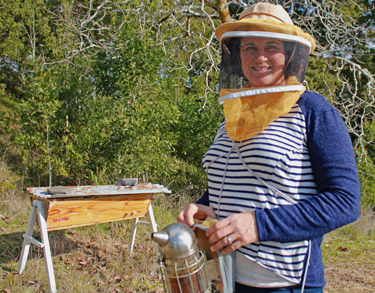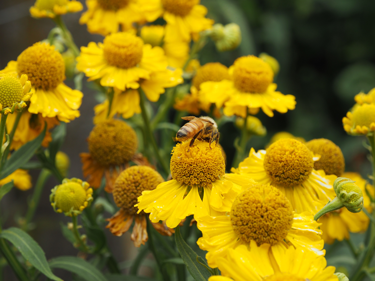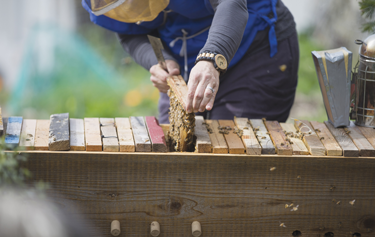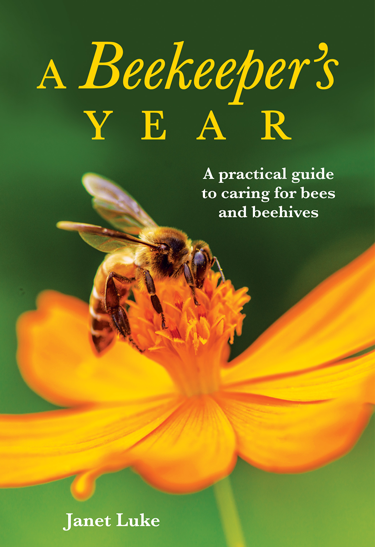Be your own beekeeper
Janet Luke is a landscape architect and author who is passionate about eco-friendly living. Her book “A Beekeeper’s Year’ will be an invaluable resource for gardeners wanting to take the plunge into beekeeping. For anyone who spends time outdoors her beautifully written account of the life of bees will enhance the appreciation and enjoyment of these precious pollinators.
What does it take to be a great beekeeper?
If you are not making mistakes you are not learning.
Inner strength
When you start beekeeping, not everything will go to plan. It can’t when you are working with insects. The stark fact is you will lose hives as your colony dies through disease or some other cause. When this happens—and notice I say when, not if—you need to pick yourself up and try and analyze what went wrong and try not to repeat the mistake. Beekeeping is always about trial and error. This is the reason why I recommend that you start with at least two hives. This way you still have one surviving hive, which you can split when the time is right.
Critical thinking
There is no set formula you can follow. Beekeeping is not a hobby that suits a paint-by-numbers mentality. Seek out information from books, the internet and others who are more experienced, but always evaluate the information before you load it into your memory. As a backyard beekeeper, always question commercial beekeeping practices, as their desired outcomes are very different from ours.
Learn how colonies choose to live in the wild and try and emulate that in your own beekeeping practice. An independent thinker will be the best kind of beekeeper, as you will always be questioning and making informed decisions.
Be nosy and probing
As a beginner beekeeper, to learn, you need to open your hive regularly. Be curious and watch, assess and learn every time you are in your hive. Keep hive notes and document what you see at each hive visit so you can compare. If you see something new or interesting research it online or look it up in books so you can gain a deeper understanding; the bees will never fail to teach you something new. On that note, never trust a beekeeper who states they know everything they need to know about bees—this means they have stopped learning.
Show respect
Accept that the honey bee will always know better than the beekeeper concerning
anything that goes on within the hive. The best beekeepers are the bees themselves. Before you do any sort of manipulation of frames or boxes, stop to consider if the bees would choose to do this if they were a wild hive.
Show calm under fire
You will get stung and how you react is paramount. Being calm and considered in everything you do within your hive will help prevent stings, as the bees are more likely to remain calm. If you are a person who gets easily anxious or fearful during a stressful episode, try and work through these incidents in your mind before they happen and have a plan for what you would do. If you have role-played it in your mind, you are more likely to have the skills to negotiate your way through it.
How hard is it to keep bees?
There is certainly a lot to learn about keeping bees and in this modern world where keeping them alive, let alone thriving, is becoming more and more difficult, it is a challenge. Your first year of beekeeping will be a steep learning curve but I can guarantee it will be very satisfying. You will never feel bored with your new hobby. The beauty of backyard beekeeping is that you can be guided by the bees, as there is no pressure to produce copious amounts of honey to keep a commercial beekeeping operation afloat.
What about children and pets?
I have all manner of feathered and furred animals in my garden and have had no problems with the interface between bees and animals! My ducks and chickens pay no attention to the Top Bar hive that is situated in their permanent run. My labrador, as a puppy, had one sting on her nose and quickly learnt that those buzzy things deserved some respect and distance. The cat can often be found lounging in the sun on top of the roof of one of my hives.
Children seem to have an inborn interest and adoration for bees. With a little education they can learn how to behave around flying bees and that a bee only stings if it is stomped on or threatened. My kids are now very calm and accepting of bees in our garden. Sure there is the odd sting, but that is really just because there is now a population of pollinators in our garden. Before our hives there were no bees. When the lawn has flowering clover or dandelions (yes, my lawn is no bowling green!) they know to wear shoes.
To be a competent and considered beekeeper you need to understand the “why” not just the “how”. Many new beekeepers just do a manipulation in their hive because this is what they have been told or shown by a mentor or other beekeeper. This is often done without really understanding why. If you gain an in-depth understanding of how the honey bee functions then you can be more informed and mindful of why you are doing anything concerning your bees and your hive. Understanding how a hive functions will make you think about which practices are unnecessary if you want to keep your bees in a more natural and bee-focused way. Many beekeepers, I think, have a “paint by numbers” mentality when they are beekeeping. I want you to learn to be your own beekeeper, not someone else’s copycat. - from ‘A beekeepers Year” by Janet Luke
Text and images extracted with permission from A Beekeeper’s Year: A practical guide to caring for bees and beehives by Janet Luke, published by New Holland, $29.99.
Flowers for bees
The happy buzz of honey bees at work means good things are going on in our gardens. Pollination, the transfer of pollen from one flower to another is essential for all of our fruiting plants. The humble honey bee is by far the most important pollinator insect responsible for pollinating a huge range of the fruits and vegetables. By planting their favourite nectar flowers we reap the benefits at harvest time.
Many garden flowers, vegetable plants, herbs and fruit trees provide valuable food for bees. Even ‘weeds’ such as the common clover that grows in lawns is a wonderful provider for bees. Bees don’t mind a messy garden! Blue, purple, white and yellow flowers are bee favourites, especially simple old fashioned flowers with a single row of petals. Planting in generous blocks of colour helps bees find them. New Zealand plants loved by bees include pohutukawa, rata, hebes and of course, manuka.
Annuals and perennials |
Common name |
||
Borago officinalis |
Borage |
||
Calendula officinalis |
Calendula |
||
Centaurea spp |
Cornflower |
||
Coreopsis varieties |
Tick seed |
||
Cosmos varieties |
Cosmos |
||
Digitalis varieties |
Foxglove |
||
Echinacea cultivars |
Echinacea |
||
Echinops varieties |
Globe thistle |
||
Helenium |
Sneezeweed |
||
Knifophia varieties |
Hot poker |
||
Lobularia marítima |
Alyssum |
||
Nepeta x faassenii |
Catmint |
||
Penstemon |
Penstemon |
||
Phacelia tanacetifolia |
Blue tansy |
||
Salvia spp |
Salvia |
||
Scabiosa |
Scabiosa |
||
Sedum varieties |
Stonecrop |
||
Thrift |
Armeria |
||
Trifolium pratense |
Common clover |
||
Verbena varieties |
Verbena |
||
Trees, shrubs and climbers |
Common name |
||
Alectryon excelsa |
Titoki |
||
Callistemon spp |
Bottlebrush |
||
Citrus varieties |
Citrus trees |
||
Cordyline australis |
Cabbage tree |
||
Hebe varieties |
Koromiko |
||
Hoheria populnea |
NZ Lacebark |
||
Knightia excelsa |
Rewarewa |
||
Kunzea ericoides |
Kanuka |
||
Lavandula varieties |
Lavender |
||
Leptospermum |
Manuka |
||
Liriodendron |
Tulip tree |
||
Metrosideros varieties |
Pohutukawa, Rata |
||
Phormium |
Flax |
||
Pittosporum crassifolium |
Karo |
||
Pittosporum egenioides |
Lemonwood |
||
Pittosporum tenufolium |
Kohuhu |
||
Rosa varieties |
Old fashioned roses |
||
Rosmarinus varieties |
Rosemary |
||
Viburnum varieties |
Viburnum |
||
Wisteria varieties |
Wisteria |
||

8-Mar-2017

Janet Luke

Helenium flowers

Removing comb

A Beekeeper's Year: a practical guide to caring for bees and beehives

